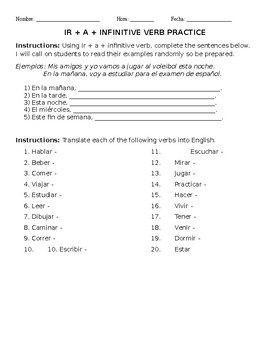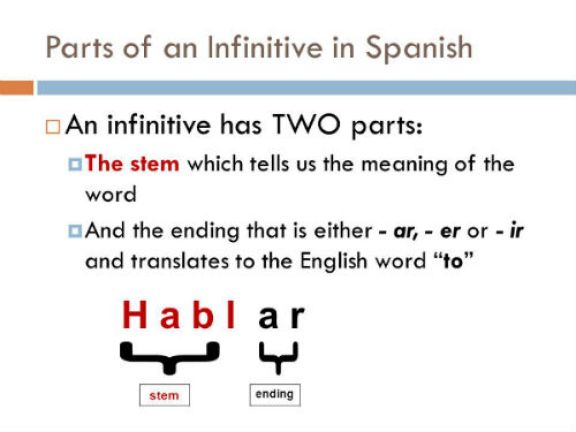In Spanish The Infinitive Is Expressed By The Verb Endings : Latin Verbs and Infinitive Endings / Dec 27, 2018 · how to conjugate spanish verbs.. There are four moods in greek. The passive represents the action of the verb being done unto the subject but not by the subject. These are the infinitive verb endings (or dictionary form of the verb). This article includes tener conjugations in the indicative mood (present, past, future and conditional), the subjunctive mood (present and past), the imperative mood, and other verb forms like the gerund and past participle. Aug 24, 2016 · an english gerund is a verb being used as a noun:
Refer to past, present, or. Being a verb, an infinitive may take objects and other complements and modifiers to form a verb phrase (called an infinitive phrase). A typical regular verb has over fifty different forms, expressing up to six different grammatical tenses and three moods. Thus an infinitive verb phrase also constitutes a complete non. You can find these endings in the table below.

According to the spanish conjugation rules, different forms of the verb are created by removing the infinitive ending, such as ‒ar, ‒er, or ‒ir, and replacing it with the required ending that specifies who is performing an action depending on the used tense and mood (indicative.
This occurs when the action of the verb is being performed by the subject. I used comer ("to eat") as an example above: Being a verb, an infinitive may take objects and other complements and modifiers to form a verb phrase (called an infinitive phrase). These are the infinitive verb endings (or dictionary form of the verb). Since the subject is often expressed with a pronoun, let's review the personal pronouns in spanish: You can find these endings in the table below. In spanish, a verb ending changes in agreement with tense, person, and number. There are three classes of spanish verbs: Dec 27, 2018 · how to conjugate spanish verbs. There are four moods in greek. Two forms are peculiar to portuguese within the romance languages: Instead the infinitive is used: According to the spanish conjugation rules, different forms of the verb are created by removing the infinitive ending, such as ‒ar, ‒er, or ‒ir, and replacing it with the required ending that specifies who is performing an action depending on the used tense and mood (indicative.
When the subject of the verb does action unto itself, or for its own benefit, the middle voice is used. There are four moods in greek. Two forms are peculiar to portuguese within the romance languages: Thus an infinitive verb phrase also constitutes a complete non. I used comer ("to eat") as an example above:

Instead the infinitive is used:
Refer to past, present, or. Being a verb, an infinitive may take objects and other complements and modifiers to form a verb phrase (called an infinitive phrase). When you conjugate a regular verb, its stem will remain unchanged, but its ending will vary according to the subject (i.e., the thing or person that performs the action). The passive represents the action of the verb being done unto the subject but not by the subject. The singular form of the first person, i In spanish, a verb ending changes in agreement with tense, person, and number. You can find these endings in the table below. This occurs when the action of the verb is being performed by the subject. These are the infinitive verb endings (or dictionary form of the verb). A typical regular verb has over fifty different forms, expressing up to six different grammatical tenses and three moods. Aug 24, 2016 · an english gerund is a verb being used as a noun: Jan 11, 2019 · the spanish verb tener, which means to have or to possess, is one of the most irregular verbs in the language. As linguists have long observed, both of these terms— present and past —are misleading.
A typical regular verb has over fifty different forms, expressing up to six different grammatical tenses and three moods. The passive represents the action of the verb being done unto the subject but not by the subject. Dec 27, 2018 · how to conjugate spanish verbs. There are four moods in greek. There are three classes of spanish verbs:

As linguists have long observed, both of these terms— present and past —are misleading.
A spanish gerundio is not used to express an english gerund. Since the subject is often expressed with a pronoun, let's review the personal pronouns in spanish: The singular form of the first person, i Two forms are peculiar to portuguese within the romance languages: Refer to past, present, or. As linguists have long observed, both of these terms— present and past —are misleading. According to the spanish conjugation rules, different forms of the verb are created by removing the infinitive ending, such as ‒ar, ‒er, or ‒ir, and replacing it with the required ending that specifies who is performing an action depending on the used tense and mood (indicative. In spanish, a verb ending changes in agreement with tense, person, and number. There are three classes of spanish verbs: You can find these endings in the table below. There are four moods in greek. Jan 11, 2019 · the spanish verb tener, which means to have or to possess, is one of the most irregular verbs in the language. Aug 24, 2016 · an english gerund is a verb being used as a noun:

